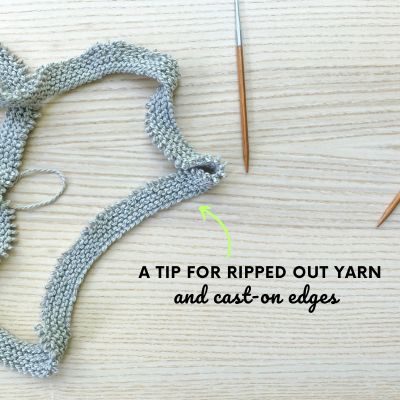Some of my knitting tips are based on particular knitting techniques or pattern construction. But this post is a tip that I’ve simply learned from my own trial and error (and passing it on to you so you can avoid some of my previous mistakes!). Just because I’m a knitting designer doesn’t mean I don’t make mistakes – actually it just means I make more of them! But it also means that I’m constantly learning and hopefully some of the tips (whether little or big) can help someone else along the way.
A Tip for ripped out yarn and cast-on edges
So here is a quick little tip that you may find helpful at some point – avoid using ripped out yarn for your cast-on.
At some point everyone needs to rip out (otherwise known as “frogging” in knitting). And if it’s relatively new knitting that I’m ripping out (i.e, not a project that has been sitting on the needles for months), then I often will just reuse the ripped out yarn. But I don’t use the ripped out yarn for my cast-on edge.
Why? Because often yarn that has been previously ripped out has a bit of a fuzz factor going on. It of course depends on the type of fiber, but I have noticed that in all types of yarn there will be at least a little bit of fuzz. And often you want your cast-on edge to be nice and clean, and that bit of fuzz from reused ripped out yarn can cause your edge to look a bit more prematurely worn out.
So if you have to rip out and re-work a cast-on edge on your project, I suggest using a fresh skein of yarn for your cast-on and then you can incorporate the ripped out yarn later on in your project. Even better would be to use that ripped out yarn in a less conspicuous spot in your project – either in an area where there is a more textured stitch pattern (textured stitch patterns will hide any fiber inconsistencies) or in the back of your work if possible.
I hope this quick little knitting tip is helpful the next time you have to rip out and re-work a cast-on edge!


